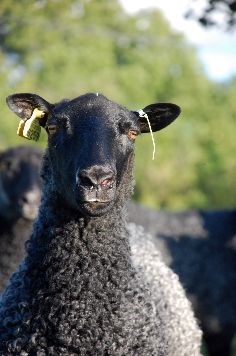Breeding goal
The Gotland sheep should be well adapted to feed on marginal land such as unfertilized meadows and pastures. The adults should have good ability to feed on both grass and herbs, as well as on bushes and leaves, thus contributing to nature preservation and open landscapes.
The lambs need better land for grazing to grow well during the last months in order gain enough weight for slaughter for the time when the lambskin is as best. The lambskin holds the highest quality during early autumn.
The Gotlands are fine-boned and of medium size, thus grazing and moving easily also on less accessible grounds. The Gotland ewe should have easy lambing and take excellent care of her lambs. The goal is that a ewe from two years age should give birth to and feed two lambs per year.
The prolificacy of the ewes and the adult weight must be adapted to the production system. The ewes shall be efficient in feed utilization. One measurement of efficiency is to calculate produced kg carcass per kg ewe. This means that adult weight should be limited to 65 to 75 kg to reach lamb carcass quality for the market and at the same time a high quality furskin under the production system mentioned above.
The weight of the slaughtered lambs should correspond to the demands from the market of a carcass weight from 17-22 kg. The carcass should reach R- to R+ on the EUROP scale at a fat classification from 2- to 3.
|
 |
|
The unique pelt qualities of the Gotland sheep shall be preserved and developed. This means:
|
- A furskin should be light and smooth, suitable for clothing. The tanned furskin should have a weight not exceeding 9 g/dm2
- A silky and lustrous wool fibre. All fibres should be as uniform as possible with a diameter of 35–45 microns.
- A clearly defined curl with a three-dimensional structure. The size should be medium to large (10–15 mm), firm and resilient, with uniform size throughout the furskin. Patterning and wide staples are preferred.
- A pure, clear (free from red, beige or brown) and uniform colour, from light to dark grey.
- A fleece well covering the leather without being too heavy
|
March 2010 (English version Feb 2018)